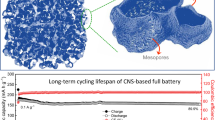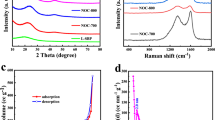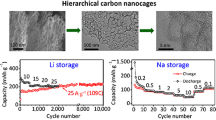Abstract
Carbon materials are the preferred anode materials for Li-ion batteries. Here, we propose an easy and sustainable strategy to prepare honeycomb-shaped porous carbon (HPC) electrode materials through a process involving simple calcination and subsequent water washing by using polyvinyl-pyrrolidone (PVP) as carbon source and NaCl as pore-forming agent. A controllable cavity size and distribution of the carbon materials can be readily obtained solely by adjusting the NaCl amount. Results showed that the optimized HPC sample had a relatively uniform cavity distribution and a highly porous structure. Moreover, the special honeycomb-shaped structure was conducive to the electronic conductivity of the electrode materials, provided a short path for Li-ion transport and a wide interface with the electrolyte, and buffered the volume change of active materials. The special honeycomb-shaped structure was also maintained well after long cycles, which improved electrode stability. When used as anode materials for Li-ion batteries (LIBs), the sample demonstrated excellent cycling stability and rate performance, with a high specific capacity of 230 mA h g−1 and a reversible capacity of 197 mA h g−1, after 1200 cycles at 2 C. Overall, we introduced a simple strategy for the potential mass production of porous carbon materials for LIBs.
Similar content being viewed by others
References
Li X, Chen Y, Wang H, et al. Inserting Sn nanoparticles into the pores of TiO2−x-C nanofibers by lithiation. Adv Funct Mater, 2016, 26: 376–383
Chen Y, Li X, Park K, et al. Hollow carbon-nanotube/carbon-nanofiber hybrid anodes for Li-ion batteries. J Am Chem Soc, 2013, 135: 16280–16283
Hu H, Yu L, Gao X, et al. Hierarchical tubular structures constructed from ultrathin TiO2(B) nanosheets for highly reversible lithium storage. Energy Environ Sci, 2015, 8: 1480–1483
Wang H, Zhang C, Liu Z, et al. Nitrogen-doped graphene nanosheets with excellent lithium storage properties. J Mater Chem, 2011, 21: 5430–5434
Long D H, Jeong M G, Lee Y S, et al. Coating lithium titanate with nitrogen-doped carbon by simple refluxing for high-power lithium-ion batteries. ACS Appl Mater Interfaces, 2015, 7: 10250–10257
Zhu S, Li J, Ma L, et al. Three-dimensional network of n-doped carbon ultrathin nanosheets with closely packed mesopores: Controllable synthesis and application in electrochemical energy storage. ACS Appl Mater Interfaces, 2016, 8: 11720–11728
Xu C, Niu D, Zheng N, et al. Facile synthesis of nitrogen-doped double-shelled hollow mesoporous carbon nanospheres as high-performance anode materials for lithium ion batteries. ACS Sustain Chem Eng, 2018, 6: 5999–6007
Zhou Y, Zhu Y, Xu B, et al. Cobalt sulfide confined in n-doped porous branched carbon nanotubes for lithium-ion batteries. Nano-Micro Lett, 2019, 11: 29
Lin J, Xu Y, Wang J, et al. Preinserted Li metal porous carbon nanotubes with high coulombic efficiency for lithium-ion battery anodes. Chem Eng J, 2019, 373: 78–85
Zhou F, Xin S, Liang H W, et al. Carbon nanofibers decorated with molybdenum disulfide nanosheets: Synergistic lithium storage and enhanced electrochemical performance. Angew Chem Int Ed, 2014, 53: 11552–11556
Zhang Y, Song N, He J, et al. Lithiation-aided conversion of end-of-life lithium-ion battery anodes to high-quality graphene and graphene oxide. Nano Lett, 2019, 19: 512–519
Liu J, Zhao T, Zhang S, et al. A new metallic carbon allotrope with high stability and potential for lithium ion battery anode material. Nano Energy, 2017, 38: 263–270
Guo J, Zuo W, Cai Y, et al. A novel Li4Ti5O12-based high-performance lithium-ion electrode at elevated temperature. J Mater Chem A, 2015, 3: 4938–4944
Chen J, Mao Z, Zhang L, et al. Nitrogen-deficient graphitic carbon nitride with enhanced performance for lithium ion battery anodes. ACS Nano, 2017, 11: 12650–12657
Shi R, Han C, Li H, et al. Nacl-templated synthesis of hierarchical porous carbon with extremely large specific surface area and improved graphitization degree for high energy density lithium ion capacitors. J Mater Chem A, 2018, 6: 17057–17066
Zhang Y, Ma Q, Wang S, et al. Poly(vinyl alcohol)-assisted fabrication of hollow carbon spheres/reduced graphene oxide nanocomposites for high-performance lithium-ion battery anodes. ACS Nano, 2018, 12: 4824–4834
Yang L Y, Li H Z, Cheng L Z, et al. A three-dimensional surface modified carbon cloth designed as flexible current collector for high-performance lithium and sodium batteries. J Alloys Compd, 2017, 726: 837–845
Zhou Y, Fang J, Wang H, et al. Multicolor electrochromic fibers with helix-patterned electrodes. Adv Electron Mater, 2018, 4: 1800104
Lin X, Kang Q, Zhang Z, et al. Industrially weavable metal/cotton yarn air electrodes for highly flexible and stable wire-shaped Li-O2 batteries. J Mater Chem A, 2017, 5: 3638–3644
Pham H Q, Lee H Y, Hwang E H, et al. Non-flammable organic liquid electrolyte for high-safety and high-energy density Li-ion batteries. J Power Sources, 2018, 404: 13–19
Rao J, Xu R, Zhou T, et al. Rational design of self-supporting graphene-polypyrrole/sulfur-graphene sandwich as structural paper electrode for lithium sulfur batteries. J Alloys Compd, 2017, 728: 376–382
Yang W, Zhou J, Wang S, et al. Freestanding film made by necklacelike N-doped hollow carbon with hierarchical pores for high-performance potassium-ion storage. Energy Environ Sci, 2019, 12: 1605–1612
Li X, Guan B Y, Gao S, et al. A general dual-templating approach to biomass-derived hierarchically porous heteroatom-doped carbon materials for enhanced electrocatalytic oxygen reduction. Energy Environ Sci, 2019, 12: 648–655
Yuan C, Liu X, Jia M, et al. Facile preparation of N- and O-doped hollow carbon spheres derived from poly(o-phenylenediamine) for supercapacitors. J Mater Chem A, 2015, 3: 3409–3415
Zhang C L, Jiang Z H, Lu B R, et al. MoS2 nanoplates assembled on electrospun polyacrylonitrile-metal organic framework-derived carbon fibers for lithium storage. Nano Energy, 2019, 61: 104–110
Balogun M S, Qiu W, Yang H, et al. A monolithic metal-free electrocatalyst for oxygen evolution reaction and overall water splitting. Energy Environ Sci, 2016, 9: 3411–3416
Niu J, Liang J, Shao R, et al. Tremella-like N,O-codoped hierarchically porous carbon nanosheets as high-performance anode materials for high energy and ultrafast Na-ion capacitors. Nano Energy, 2017, 41: 285–292
Wang X, Liu B, Hou X, et al. Ultralong-life and high-rate web-like Li4Ti5O12 anode for high-performance flexible lithium-ion batteries. Nano Res, 2014, 7: 1073–1082
Wang S, Guan B Y, Yu L, et al. Rational design of three-layered TiO2@Carbon@MoS2 hierarchical nanotubes for enhanced lithium storage. Adv Mater, 2017, 29: 1702724
Xiong W, Wang Z, Zhang J, et al. Hierarchical ball-in-ball structured nitrogen-doped carbon microspheres as high performance anode for sodium-ion batteries. Energy Storage Mater, 2017, 7: 229–235
Zhou X, Liu Y, Du C, et al. Polyaniline-encapsulated silicon on three-dimensional carbon nanotubes foam with enhanced electrochemical performance for lithium-ion batteries. J Power Sources, 2018, 381: 156–163
Liu Y, Fang X, Ge M, et al. SnO2 coated carbon cloth with surface modification as Na-ion battery anode. Nano Energy, 2015, 16: 399–407
Idrees M, Abbas S M, Ata-Ur-Rehman S M, et al. Mechanistic insights into high lithium storage performance of mesoporous chromium nitride anchored on nitrogen-doped carbon nanotubes. Chem Eng J, 2017, 327: 361–370
Xie Q, Zhao P, Wu S, et al. Flexible carbon@graphene composite cloth for advanced lithium-sulfur batteries and supercapacitors with enhanced energy storage capability. J Mater Sci, 2017, 52: 13478–13489
Veeraraghavan B, Paul J, Haran B, et al. Study of polypyrrole graphite composite as anode material for secondary lithium-ion batteries. J Power Sources, 2002, 109: 377–387
Etacheri V, Wang C, O’Connell M J, et al. Porous carbon sphere anodes for enhanced lithium-ion storage. J Mater Chem A, 2015, 3: 9861–9868
Tang J, Etacheri V, Pol V G. Wild fungus derived carbon fibers and hybrids as anodes for lithium-ion batteries. ACS Sustain Chem Eng, 2016, 4: 2624–2631
Yang M, Liu J, Li S, et al. Ultrafast synthesis of graphene nanosheets encapsulated Si nanoparticles via deflagration of energetic materials for lithium-ion batteries. Nano Energy, 2019, 65: 104028
Cho J S, Park J S, Kang Y C. Preparation of hollow Fe2O3 nanorods and nanospheres by nanoscale kirkendall diffusion, and their electrochemical properties for use in lithium-ion batteries. Sci Rep, 2016, 6: 38933
Lee K, Shin S Y, Yoon Y S. Fe3O4 nanoparticles on MWCNTs backbone for lithium ion batteries. J Korean Ceram Soc, 2016, 53: 376–380
Park J S, Chan Kang Y. Multicomponent (Mo, Ni) metal sulfide and selenide microspheres with empty nanovoids as anode materials for Na-ion batteries. J Mater Chem A, 2017, 5: 8616–8623
Zhang S F, Wang W P, Xin S, et al. Graphitic nanocarbon-selenium cathode with favorable rate capability for Li-Se batteries. ACS Appl Mater Interfaces, 2017, 9: 8759–8765
Subramaniyam C M, Srinivasan N R, Tai Z, et al. Self-assembled porous carbon microparticles derived from halloysite clay as a lithium battery anode. J Mater Chem A, 2017, 5: 7345–7354
Kim A, Jung H, Song J, et al. Lithium-ion intercalation into graphite in SO2-based inorganic electrolyte toward high-rate-capable and safe lithium-ion batteries. ACS Appl Mater Interfaces, 2019, 11: 9054–9061
Wang Y, Zheng X, Qu Q, et al. A novel maleic acid/graphite composite anode for lithium ion batteries with high energy and power density. Carbon, 2018, 132: 420–429
Hsu Y H, Lai C C, Ho C L, et al. Preparation of interconnected carbon nanofibers as electrodes for supercapacitors. Electrochim Acta, 2014, 127: 369–376
Yue W, Tao S, Fu J, et al. Carbon-coated graphene-Cr2O3 composites with enhanced electrochemical performances for Li-ion batteries. Carbon, 2013, 65: 97–104
Wang Y, Qu Q, Liu G, et al. Aluminum fumarate-based metal organic frameworks with tremella-like structure as ultrafast and stable anode for lithium-ion batteries. Nano Energy, 2017, 39: 200–210
Zhou Y, Li Y, Yang J, et al. Conductive polymer-coated VS4 sub-microspheres As advanced electrode materials in lithium-ion batteries. ACS Appl Mater Interfaces, 2016, 8: 18797–18805
Huang X, Cui S, Chang J, et al. A hierarchical tin/carbon composite as an anode for lithium-ion batteries with a long cycle life. Angew Chem Int Ed, 2015, 54: 1490–1493
Zhu P, Zhang Z, Hao S, et al. Multi-channel FeP@C octahedra anchored on reduced graphene oxide nanosheet with efficient performance for lithium-ion batteries. Carbon, 2018, 139: 477–485
Author information
Authors and Affiliations
Corresponding author
Additional information
This work was supported by the National Natural Science Foundation of China (Grant Nos. 51662029 and 21363015), and the Graduate Innovation Fund Projects of Jiangxi Province (Grant No. YC2018-S013).
Supporting Information
The supporting information is available online at tech.scichina.com and link.springer.com. The supporting materials are published as submitted, without typesetting or editing. The responsibility for scientific accuracy and content remains entirely with the authors.
Supporting Information
Rights and permissions
About this article
Cite this article
Fang, S., He, H., Yu, Y. et al. Facile construction of honeycomb-shaped porous carbon electrode materials using recyclable sodium chloride template for efficient lithium storage. Sci. China Technol. Sci. 63, 2123–2130 (2020). https://doi.org/10.1007/s11431-019-1557-2
Received:
Accepted:
Published:
Issue Date:
DOI: https://doi.org/10.1007/s11431-019-1557-2




